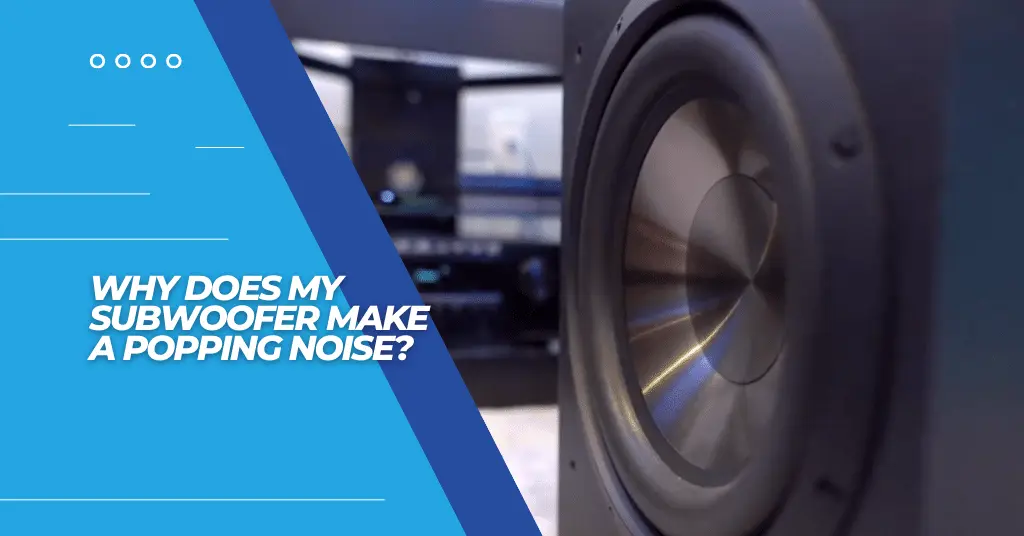Why Does My Subwoofer Make a Popping Noise?

Many reasons, such as overpowering, amplifier clipping, audio input setting, damaged dust cap or voice coil, or loose connection, can cause your subwoofer to make cracking or popping noises. There are many reasons that you can solve yourself. But some of them require replacements or even professional help to solve.
Just to let you know! You’re not the only one who’s facing such a problem. Many audiophiles have gone through the problem, which they have fixed and avoided the mistakes to prevent the popping sound from happening again. Now you will ask me, “Why does my subwoofer make a popping noise?”. Read the article till the end!
Reasons That Make Your Subwoofer Make a Popping Noise:
Let’s discuss the reasons in detail that can cause such unusual sounds from your subwoofer below:
Overpowering:
This is the most common reason I’ve found whenever I troubleshoot the cracking noise. Overpowering (power mismatch) an amplifier can cause a popping sound from the subwoofer due to excessive strain on the speaker. You will probably find yourself in trouble when the amp’s gain or volume setting is too high and causes more power than the speaker can handle.
When this happens, it forces too much pressure on the voice coils causing them to release energy in short bursts of sound, resulting in noticeable popping noises.
How to Solve Overpowering?
To avoid this unpleasant sound, it’s essential to keep your amplifier’s gain or volume at a low setting so that it does not exceed the limits of your subwoofer. Furthermore, you should ensure that your subwoofer and amplifier have the same impedance levels. By taking these preventive measures, you can reduce these popping sounds and enjoy clear audio without disruptions.
Damaged Voice Coil
That’s another internal physical problem that most subwoofers go through. A damaged voice coil can cause popping or crackling noises from the subwoofer. These voice coils make the speaker cones move, resulting in low frequency from subwoofers.
When they are worn out, they start to come into contact with other components inside the speaker. This contact produces a popping noise as an electrical discharge jumps between them, creating a brief loud sound. If your subwoofer shows blown voice coil symptoms, that’s the moment you need to take the step to prevent any additional damage.
How to Fix Damaged Voice Coil?
You’ll need to replace the voice coil with a new one to fix the problem. An audio technician (just like me) can help with this process, as they have the necessary tools and skillset to diagnose and repair any issues that may be present in your subwoofers.
Loose Connections:
Audio input issues (improper connection, too), such as loose connections, can cause your subwoofer pops due to an interruption in electrical current or specific audio signal. When you use low-quality RCAs, the RCA cables get loosened over time; it creates an arc and causes loud popping noises. Additionally, any corrosion on the connectors could lead to higher resistance and create further issues with continuity leading to pops and clicks.
How to Tight the Loose Connections?
You should keep inspecting all connections regularly for damaged signs or looseness. Also, ensure you use high-quality RCA cables. You should also clean both the male and female terminals of each connection and ensure they are firmly connected.
Finally, you should take extra care when connecting your subwoofer to an amplifier or speaker wires, as these tend to be more prone to loosening over time if not adequately secured.
Dust Cap Damage:
Not so many audio experts talk about the damaged dust cap! The dust cap on a subwoofer cone is essential for its proper functioning. When it gets damaged or detached, air can pass through the gap between the dust cap and the cone, creating popping or crackling sounds.
It can also cause sound quality distortions and weaken the bass output. Subwoofers with damaged dust caps require repair as soon as possible to restore their performance and avoid any further damage caused by these noises.
How to Replace Damaged Dust Cap?
You must visually inspect your subwoofer’s dust cap. If it is damaged, you need to replace the dust cap then. The replacement process involves removing your speaker and carefully lifting off the dust cap through a flathead screwdriver (You can use a hairdryer to weaken the adhesive).
Once the damaged dust cap is removed, clean the area through an air compressor. Then, apply a small amount of glue on the spot and gently push down the new dust cap on the cone’s location.
Power Fluctuations (Damaged Power Supply):
A popping noise occurs when the power supply to your subwoofer is damaged or unstable. This is due to sudden fluctuations (power outage) in current and voltage, which will be particularly noticeable when connected to a powerful device like the subwoofer. Power fluctuations can damage various components of the subwoofer, such as capacitors, resistors, and transistors, causing popping sounds that should not be audible.
How to Solve This Issue?
To solve power fluctuations that may cause popping noises from subwoofers, you should first check the sound system and ensure it is connected to a protected and stable power outlet (You can use a multimeter to test). Also, ensure the audio cables are correctly connected.
If these measures do not resolve the issue, then try using a surge protector or line conditioner for better protection against power fluctuations.
Blown Fuse Coil:
A blown fuse in the subwoofer can cause popping sounds due to an electrical short. A fuse blows when electricity is not flowing correctly through the system, creating a circuit and producing shorts. In this case, the fuse acts as a safety measure by cutting off power momentarily to prevent damage to other components.
When a fuse blows, sparks can jump across the ends of its connection, causing the popping noise you hear from your subwoofer. If your subwoofer keeps blowing fuses, there must be an internal issue with your car sound system that you need to address immediately to avoid any significant loss.
How to Fix Blown Fuse?
To fix a blown fuse, you must disconnect the power and open up the subwoofer’s case. Once inside, visually inspect each component for signs of damage or overheating before replacing any burnt-out fuses with identical ones of equal value or higher.
Amplifier Clipping (Faulty Amp):
When you push an amplifier beyond its limit, it will start producing the clipped audio signal. That clipping will result in distortion because the subwoofer amp has a signal higher than its maximum output. Instead, you get a smooth waveform sound; the amplifier will “clip” off the top and bottom of the waveform, resulting in a popping frequency from the subwoofer. (Amplifier gradually heats when this happens)
How to Prevent Amp Clipping?
To prevent amplifier clipping which causes the popping noises from your subwoofer, make sure that your amplifier is matched for the correct size of the speaker, and set the gain and volume appropriately. Additionally, use high-quality audio cables to ensure maximum signal quality without distortion. Double-check that you haven’t turned up the volume too high, which can cause clipping in some amplifiers.
Setting Gain Too Low or Too High:
I was amazed when I first learned about this problem. Setting the gain too low or too high on a subwoofer can cause popping noises. When the gain is set too low, insufficient power goes to the subwoofer, causing volume levels to be turned up excessively and leading to distortion. On the other hand, setting the gain too high causes excessive power sent from the amplifier and results in sound distortion with pops or cracking noises.
How to Set Gain?
You can easily set the gain correctly by playing a test tone frequency. This will help to calibrate the amplifier’s output level to match the subwoofer’s input level. Adjust the gain until you find an appropriate level for your specific setup, and ensure that no pops or crackles are heard.
Steps to Fix Popping or Cracking Sound:
Additionally, follow the below steps to fix the popping sound from your subwoofer quickly:
- First, turn off your stereo receiver.
- Now, ensure you have solid connections between your subwoofer and receiver. Also, make sure your cables are not damaged. If damaged, replace them with new ones.
- You must turn off any nearby electronic devices (input device included) to ensure the popping sound is not being produced because of electrical interference.
- Furthermore, you need to check for any ground loops. If present, you must adequately ground your subwoofer to prevent the constant popping noise from the subwoofer.
- Ensure to separate speaker wires from power cables to prevent any electrical interference.
- If there’s still the issue, try to reset the receiver audio settings to make a fresh start.
- If the problem continues, seek professional help.
General FAQs
How Do You Fix Popping in a Subwoofer?
To fix popping in a subwoofer, check the connections and ensure they are adequately secured. If that doesn’t help, replace the speaker wires with higher-gauge cables or install an external amplifier. Lastly, adjusting the crossover settings or enabling bass boost may reduce distortion.
What Does It Mean When Your Subwoofer Pops?
When your subwoofer pops, it usually indicates that the speaker has been overdriven and has gotten too loud. Additionally, a pop can happen when turning on the power or plugging in a cable. Both cases could indicate a malfunctioning connection or the need for repairs.
What Are the Symptoms of a Blown Subwoofer?
The symptoms of a blown subwoofer include distortion, odd or rattling sounds, low sound output, and no sound at all. When there is excessive power sent to the subwoofer, it may be damaged. A blown subwoofer should be checked out and replaced if necessary.

After returning my first LG soundbar with bluetooth subwoofer to LG due to the constant popping sound from the subwoofer, I replaced it with ANOTHER, more expensive LG SP8YA soundbar with wireless bluetooth subwoofer. About three months in on this replacement, I began getting the same popping from subwoofer. Endured it, in poor frame of mind about the situation, for several months, trying various things, moving equipment, resetting, unplugging, replugging, etc. Maddening. Then, during further internet research, I stumbled across a Klipsch posting. This kind of problem seems to result from a form of electrical line interference, feedback, or some such. The Klipsch site recommended placement on the offending device’s power input electrical line of a ferrite ring core clip device. Ordered a set of twenty of these (assorted sizes) from Amazon for less than $10; placed the appropriately sized clip on the line, and it has solved the problem for several days now. Keeping my fingers crossed. Anywho – give a ferrite ring a shot. Blind luck on my part, aggravating as Hell problem which apparently plagues many users. It’s hard to believe manufacturers don’t make this device widely known to consumers.
Thank you so much for sharing your experience with the LG soundbars and the specific issue you faced with the subwoofer. Your determination in troubleshooting this problem is truly commendable, and I’m thrilled to hear that you found a solution using a ferrite ring core clip device.
Your insight into this matter is incredibly valuable, not only to our community but also to the manufacturers who may need to address this issue. It’s feedback like yours that helps others facing similar problems and encourages companies to improve their products and communication.
If you encounter any other challenges or have further insights to share, please don’t hesitate to reach out. We’re here to help and learn from each other. Once again, thank you for taking the time to provide this valuable information, and I hope your soundbar continues to perform without any more hitches!